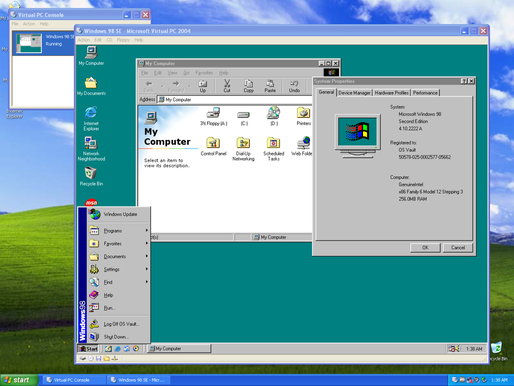

- #Ms virtual pc 2004 install#
- #Ms virtual pc 2004 software#
- #Ms virtual pc 2004 iso#
- #Ms virtual pc 2004 professional#
- #Ms virtual pc 2004 windows#
Their time and expertise, we now have the following games that are either
#Ms virtual pc 2004 windows#
As far as testing Linux on Windows hosts is concerned, Microsoft’s Virtual PC 2007 doesn’t even come close to being considered a viable alternative.For the record, and thanks to the help of fellow Boomers who kindly donated If you need to run Linux under Windows there’s QEMU, Bochs, Virtual Box, VMware Player and VMware server.
#Ms virtual pc 2004 software#
There’s no dearth of free-as-in-beer or open source and free software virtualization software. Microsoft does offer an add-on package called Virtual PC Additions, which is similar to VMware’s VMtools package, which allows file transfer between the host and Windows guests. This is extremely irritating since VPC doesn’t allow drag-and-drop of data between the host Windows and Linux guests. But it’s not suitable for even this, since it lacks support for USB storage devices.Įven guest Windows OSes will not be able to use USB drives. To top it all, the VPC 2007 virtual machines were stable and none of them crashed.ĭespite the pitiful performance while installing distributions, I probably could’ve recommended VPC 2007 for testing Live Linux distributions. I wouldn’t get this performance if there were issues with the virtual hardware. For example, 2.0 takes less than 10 seconds. Even when inside the distribution, there isn’t any noticeable difference between application launch times. Ubuntu and Pardus took about the same time to boot that they do on a similar VMware virtual machine. But when I powered up the virtual machines, I was surprised by the performance of the installed distributions.
#Ms virtual pc 2004 install#
Now I was almost positive that the issue was with the virtualized hard disks, which would explain the performance from the live CDs, and the exhaustive install times. Pardus took almost three hours to install, compared to the 40 minutes it took via VMware.
#Ms virtual pc 2004 iso#
Thinking the issue could be with my physical DVD drive, the virtualized CD drive, or the installation media, I tried installing the single CD Pardus Linux 2007 from its ISO image. I also tried the Slackware Linux 11 text-based installer and gave up after about five hours and two CDs. But I can’t do anything about it, since the only configurable hard disk parameter is its size. The issue could be with VPC trying to virtualize an IDE disk on my physical SATA drive. The same procedure, on a virtual machine with the same specs, created with VMware Workstation, takes about half an hour. On VPC 2007, the file copying process took about 2 hours. Since Ubuntu is a single CD install, it doesn’t usually take very long to install.

So, I followed the instructions on the Wiki and got to the Ubuntu 6.10 live CD desktop and started installation. It’s rather strange that VPC 2007 still has this issue, but at least the problem is understood. Installing Ubuntu in Virtual PC 2007 – click to viewīasically, I had to modify my X server’s configuration file to change the default display depth to 16 bits instead of the default of 24. A quick Google search led me to the Ubuntu Wiki which has a page on configuring Ubuntu for the previous release of VPC, Virtual PC 2004. VPC 2007 had trouble displaying the Ubuntu desktop. First up was Ubuntu 6.10, which is installable via its live CD environment. Satisfied with the performance of the live CDs, I decided to test some installable distributions. Next in line was the latest FreeBSD-based live CD, FreeSBIE 2.0 - which, like Knoppix, worked like a charm. The guest system plugged into my network through a bridged connection, got its own IP address and networking worked seamlessly. Impressed, I fired up 2.0, which loaded up in a matter of seconds. Boot up and hardware recognition went fine, and I was at the KDE desktop in less than 20 seconds after powering up the machine. The first distribution I tried was Knoppix 5.0. For the test I created a guest with 512MB RAM and a 6GB hard disk with pre-allocated space to reduce over-head. VPC 2007 supports IVT for improving performance. My test computer has the Intel Core 2 Duo E6300 processor with the IVT virtualization extension. The “Use default settings to create a virtual machine” option creates a useless VM with 128 MB RAM and no hard disk. You can choose to go through a detailed procedure to create a virtual machine, or let VPC create one for you.

VPC’s interface is pretty simple and straightforward.
#Ms virtual pc 2004 professional#
VPC 2007 only runs on Windows XP Professional and later versions of Windows. The biggest news in this release of Virtual PC 2007 is its support for Windows Vista, both as host as well as guest OS.


 0 kommentar(er)
0 kommentar(er)
